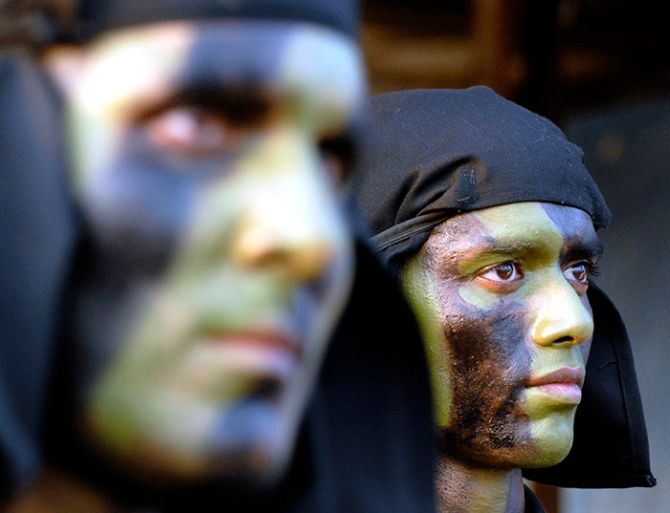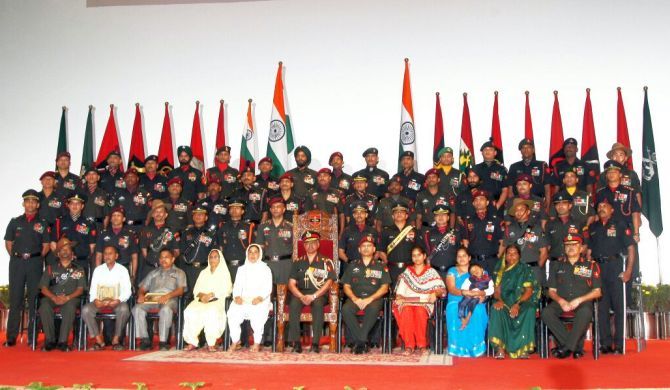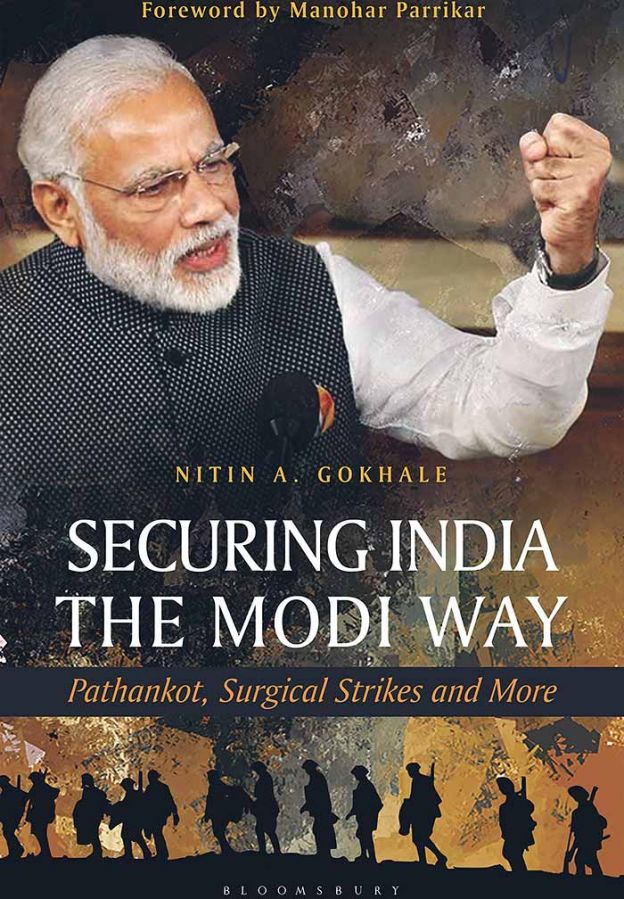'We knew we had to hit the adversary so hard that he would be humiliated.'
Soldiers who took part in last year's surgical strikes on terror camps inside PoK tell Nitin A Gokhale what happened in those hours.
An exclusive excerpt from Nitin's fascinating new book, Securing India the Modi Way: Pathankot, Surgical Strikes and More.

The week of the Uri attack was also a testing time for the Prime Minister's leadership.
Modi, adept at judging the public mood, was aware that people expected him to 'walk the talk' in acting tough against India's implacable enemy.
Public opinion in the country was inflamed.
People were calling for an all-out war against Pakistan.
Even saner voices were advocating at least some demonstrable retribution.
Modi was aware of the public sentiment and the anger that was building up in popular perception.
He vowed immediate retribution. 'I assure the nation that those behind this despicable attack will not go unpunished,' he tweeted on the day of the Uri attack.
Not many people took the statement at face value.
After all, politicians and prime ministers in the past had pledged stern action against terrorists and their handlers many times, but had ultimately refrained from giving that final go ahead required to retaliate, urging restraint instead.
Amidst all the criticism, the Prime Minister continued to be unruffled. Recall his aides: "The PM went through with his daily routine and pre-scheduled appointments and programmes without any change, but made sure he had all possible options presented to him before giving the final go ahead (for a punitive strike against Pakistan)."
All options, economic, political, and diplomatic were considered.
They ranged from downgrading diplomatic ties, revisiting the provisions of the Indus Water Treaty, mobilising international opinion by furnishing proof of Pakistan's complicity in terrorist attacks, and, of course, punish Pakistan militarily.
But he was not about to be rushed into any hasty decision. The Prime Minister however made up his mind by 23 September, five days after the Uri attack.
Later that evening, he and Doval, escorted by a major general from the Military Operations Directorate, walked the length of the South Block corridor from the PMO to the Army HQ Ops room around 2100 hours, much long after the corridors had been emptied and offices had closed.
Already present in the room were Defence Minister Manohar Parrikar, Army Chief Gen Dalbir Singh, DGMO, Lt Gen Ranbir Singh, and a couple of MO Directorate senior functionaries. The PM sat through the briefing silently, listening with rapt attention.
He was presented various options, shown targets that were planned to be hit inside PoK, and briefed on the possible retaliation/reaction by Pakistan.
Once the initial briefing was over, Modi had a couple of questions on other possible options like a precise air strike on terrorist camps, remembers a participant.
Eventually, the Prime Minister agreed that a Special Forces raid across the frontier was the best possible course of action at that point, the participant added.
As one week passed after the Uri attack, the debates tapered off; people seemed resigned to live with the bitter fact that the situation in J&K and on the LoC would continue to be volatile with the Indian Army unable to take any deterrent steps.
Little did anyone know that India was about to unleash unprecedented and audacious cross-border strikes.
Once the political call was taken, the wheels began to move faster.
In Udhampur, the Ops room was buzzing with activity. Now was the time to bring the two Corps Commanders of 15 and 16 Corps in the loop.
Accordingly, Lt Gens Satish Dua and R R Nimborhkar, heading the Srinagar-based Chinar and Nagrota-based White Knight Corps respectively, were also brought on board.
Col H and Col K meanwhile were back to their respective bases. They had much to do.
Both had finalised the targets, but the men had to be selected for different tasks, although in their mind they had already earmarked some key personnel the previous winter when the entire units were training together.
As Col H remembers, "Most of our reorientation took place in the mind; we were crossing a threshold that had been embedded in the mind: Thus far and no further. Now we were being asked to do a job that had not been undertaken in decades."
Adds Col K: "Our boys always had the skills, but they had applied the skills to a different set of circumstances, not the task we were about to undertake. However, due to our practice and reorientation, they were at the peak of their skills."
They were, like many Indian Army officers before them posted along the LoC, aware of one-off, shallow raids launched by different infantry units into PoK. But all of them were individual punitive actions and not large-scale planned operations like the one that was being contemplated now.
The tasks were diverse. Teams had to be formed accordingly.
Over the past quarter century, the Indian Army had created a strong network of intelligence operatives in the valley and within various tanzeems based in Pakistan occupied Kashmir.

Post the Uri attack and around the time when the surgical strike was being finalised, Northern Command tapped a couple of sources in Hizbul Mujahideen, located in the general area of Anantnag, to obtain more information about the layout of Pakistani camps, and the possible routes that could be taken both to enter and exit PoK.
These inputs were crucial to plan strategy and form teams for different tasks like mounting secret surveillance, raid the camps, and for guiding the troops back safely.
They also had to do last minute rechecking of targets to make sure that the terrorists were still holed up there and launch pads were not emptied out after the Uri attack.
So what were the thoughts that were going through their minds as they prepared to launch the strikes, I asked the two Commanding Officers.
Looking back, with a quiet sense of pride in their eyes, both the officers recalled their state of mind: "We knew we had to hit the adversary so hard that he would be humiliated. There was no time for half-measures, no place for token gestures," recounted Col K.
His colleague added: "This is what we train for: That one chance to deliver a blow so lethal that the enemy will constantly think about it when planning any misadventure."
Accordingly, the COs were told that the intent of the cross-border strikes was two-fold: Inducing fear and extracting revenge.
Simultaneously, total destruction of terrorist infrastructure directly opposite Uri was planned so that those who had launched the attack on 18 September would get the right message.
"The idea was to let them know that we know where you are based and where you launch your attacks from and more importantly, we know where to hit you."
The message had to go up to Muzzafarabad (the capital of PoK), Col H said, reflecting upon the week in the run up to the actual operation.
The wait was now getting shorter. It was finally over on 28 September.
That afternoon, Lt Gen D S Hooda (the Northern Army Commander) signalled the launch of Operation X when he called both Col H and Col K.
Separately, he wished them a simple 'good luck' and told them to go ahead and complete the assigned task.
Teams surged forward by late evening, poised on the edge of the LoC, ready to cross over later that night.
Back in Delhi, Gen Dalbir briefed NSA ((Ajit)) Doval about the mission plan and worked out a mechanism to update him as and when he received inputs from the ground.
"The die was cast now. The onus was on the army that I was leading to deliver. But I was confident of our success," Gen Dalbir recalls.
Parrikar, meanwhile, was separately briefed about the roll-out of the action plan by the Army Chief.

From here onward, teams led by Col K and Col H were on their own.
All of it depended on their skills, daring, ingenuity, and above all, determination to succeed in whether they would accomplish the task assigned to them.
There was no looking back now.
The operation, called Operation X in conversation, but not officially named as such, was being monitored at Army HQ in Delhi, at the Northern Command HQ in Udhampur, and at Nagrota and Srinagar, the HQs of 16 and 15 Corps respectively.
As prime time television debates across different news channels were just about winding down, Col K's teams were making their way to the LoC.
Col K, assigned to target camps south of the Pir Panjal range, led his teams across the LoC around midnight.
In four hours, they were in close proximity of the objectives. Having bypassed some of the outposts close to the LoC on the Pakistani side, the teams were now truly behind enemy lines.
Barring one minor injury, Operation X had gone off with clockwork precision.
Complete surprise was achieved, resulting in the higher fatalities in the camps-cum-launch pads of the Pakistanis. It also validated many conceptual plans made over the years for trans-LoC operations.
So what was the death count? I asked the two COs.
Both were candid, admitting they didn't stop to count the dead.
"That was neither our remit nor the objective of the strike. We had been given a job to destroy selected targets to send a message. In light of which we performed to the best of our abilities. We can't give you exact figures. No one can, but what we saw with our eyes in those moments, tells us that we would have accounted for at least 70-75 fellows combined," both Col K and H tell me.
Later that day, radio chatter from across the LoC reportedly confirmed at least 80 fatalities in the camps that were hit by Indian special forces.
Excerpted from Securing India the Modi Way: Pathankot, Surgical Strikes and More by Nitin A Gokhale, Bloomsbury Publishing India. Excerpted with the author's kind permission.









